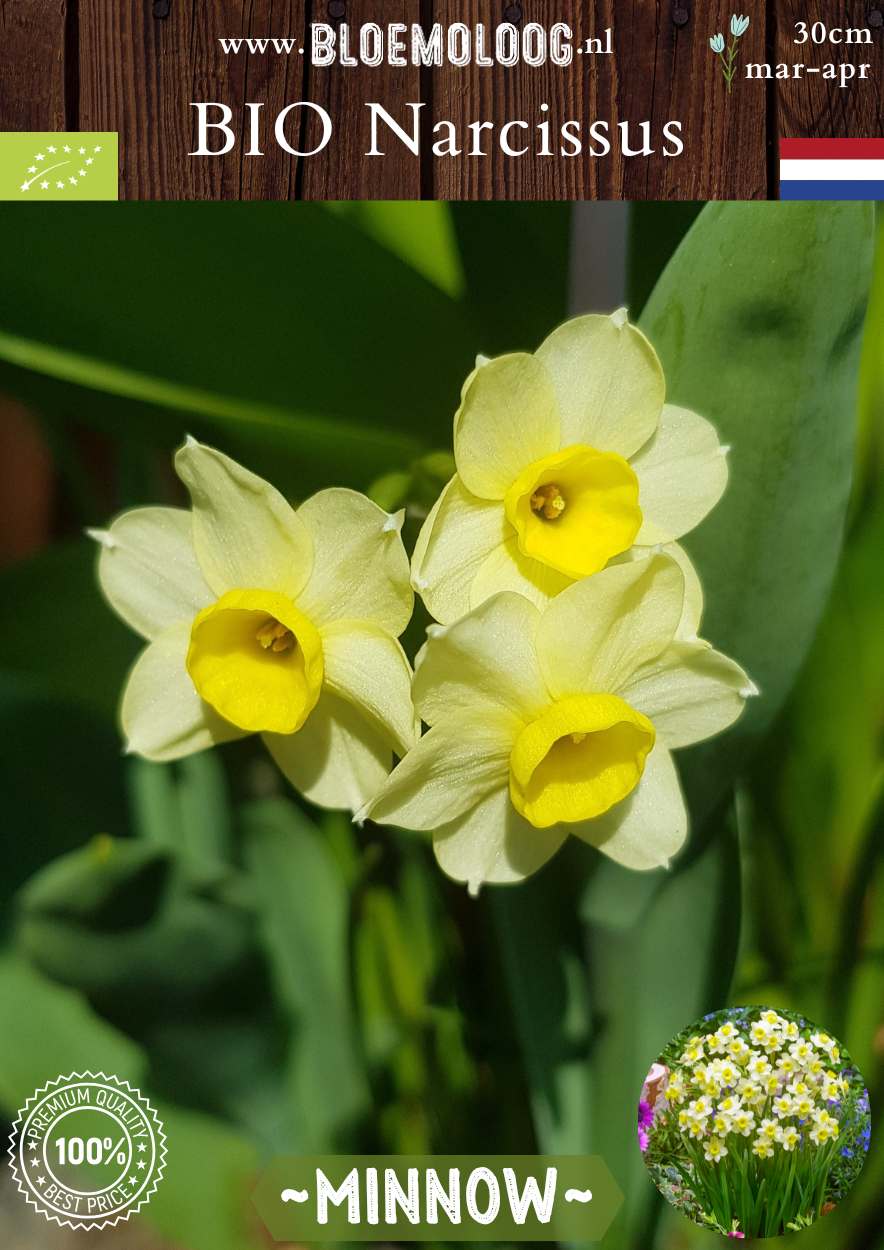Bloemoloog
Estimated Shipping Widget will be displayed here!
Couldn't load pickup availability
Organic Botanical Daffodils
The Narcissus tazetta 'Minnow' is a stunning dwarf daffodil that, despite its relatively low height, stands out with its striking presence. It also gives off a lovely fragrance that bees absolutely adore! This daffodil is ideal for both pots and garden planting.
The Narcissus 'Minnow' is a botanical daffodil from the tazetta family, featuring small creamy flowers with a petite yellow cup. This family includes compact daffodil varieties that produce multiple blooms. The plant reaches a height of about 30 centimeters and has several bluish-green flowering stems per bulb. The narrow, elongated leaves grow above the flowers, and each stem can carry 5 to 10 blooms. This daffodil blooms early, for approximately four weeks between March and April.
It’s very suitable as a cut flower, has a delightful scent, and pollinators such as bees can easily access the nectar through the open cup.
Combine it with Tulipa 'Little Beauty' or Tulipa tarda for a beautiful effect.
How, where and when to plant a daffodil bulb?
A daffodil bulb needs a cold period. Plant it in the ground from September to January. The planting depth should be 2 to 3 times the height of the bulb, and the spacing should be 2 to 3 times the width of the bulb. In pots, bulbs can be planted closer together and may partially stick out above the soil for decorative effect. However, after blooming, bulbs should be replanted in the garden at the correct depth and spacing.
Plant 'Minnow' in a sunny to semi-shaded spot in the garden, lawn or in pots. Plant it in groups in nutrient-rich, well-drained, preferably lime-rich sandy soil.
Daffodil bulbs are toxic and are therefore avoided by rodents such as voles. Use them to protect other flower bulbs by planting among and around them.
Care
Add organic fertilizer when planting. Remove spent blooms from the top, but allow the rest of the foliage to die back naturally. Cut back the foliage only once it has fully withered. The 'Minnow' daffodil is a strong variety that naturalizes well. It returns faithfully each year. For best results, apply organic fertilizer annually.
Propagation
To propagate, the bulb can be dug up in early summer. Let it dry and store it in a warm place. From September, you can plant them again. Plant the small bulblets separately and add organic fertilizer to help them grow faster.
Origin and History
The Narcissus tazetta 'Minnow' was introduced in the mid-20th century. It has received the RHS Award of Garden Merit for its garden performance.
Order Information for Bio Narcissus tazetta 'Minnow'
✅ Skal certified: 109459
📦 Packaged per 10 bulbs or choose volume discount!
💰 Volume discount: E
🛒 Pre-sale - Shipping starts mid-September!
📬 EU Shipping €8.95 – Free shipping on orders over €100.
Characteristics
| Flowering period: | March - April |
| Planting time: | From September |
| Planting depth: | 10 cm deep |
| Spacing: | 10 cm apart |
| Height: | 30 cm tall |
| Flower diameter: | 7 cm wide |
| Position: | Semi-shade, sun |
| Soil pH: | Clay, loam, sand – slightly acidic to neutral |
| Winter hardiness: | Very hardy |
| Propagation: | Good (naturalizes) |
| Origin: | Western Europe |
| Family: | Amaryllidaceae (daffodil family) |
| Group: | Tazetta |
| Color: | Cream with yellow |
| Bee-friendly: | Yes |
| Fragrant: | Yes |
| Bulb size: | 10/12 |
More daffodils

NL-BIO-01
To share








